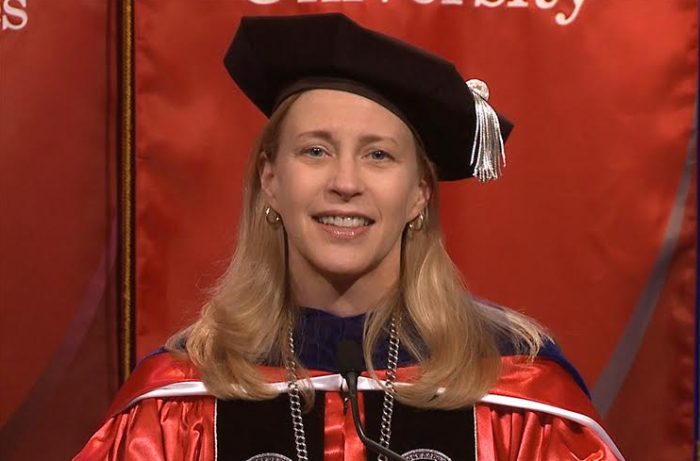Stony Brook Director of Athletics Shawn Heilbron has announced that women’s basketball head coach Ashley Langford has signed a contract extension through 2028.

“Our women’s basketball program is thriving under Ashley’s leadership, and I am very excited to extend our partnership together. Ashley is a tremendous competitor and a caring mentor who invests so much of herself in our student-athletes on and off of the court. I look forward to celebrating many successes for our women’s basketball team this year and into the future.”
Over her two seasons on Long Island, Langford has guided the Seawolves to a stellar 41-19 record, including a 23-5 mark at Island Federal Arena. Coach Langford has posted the highest winning percentage (.683) of any head coach in program history and the team has averaged 20 wins per season under her watch.
“I’d like to thank President McInnis and Shawn Heilbron for their continued belief in me and our program. I’d also like to thank my staff – you continuously pour into our women, and each of you has a tremendous, positive impact on the program. I love this University, the players, staff, and our community. I’m elated to serve as your head coach through 2028, as I know our future will be full of many wins on and off the court,” said coach Langford.
In her second year at the helm in 2022-23, Langford guided the program into a new era as the team embarked on its first season in the CAA. The Seawolves finished the year 18-13, 11-7 CAA, earning the No. 6 seed in the CAA Tournament where they defeated Elon in the first round to pick up their first-ever win in the tournament.
Langford’s offensive style proved to be pivotal in the CAA as the team finished the season second in the conference in scoring average with 67.9 points per game.
Under coach Langford’s tutelage, three student-athletes were tabbed to the All-CAA Team and helped them have career seasons on the Island. Anastasia Warren was named to the All-Conference First Team, forward Sherese Pittman claimed All-Conference Second Team honors, and guard Gigi Gonzalez was selected to the Third Team.
The trio of Warren, Pittman, and Gonzalez all upped their scoring outputs from the season prior under coach Langford. Warren averaged 12.0 points per game in 2021-22 and finished at 16.4 points per game, the fourth-most in the CAA. Pittman averaged 0.5 points per game in 2021-22 at JMU and finished the 2022-23 season averaging 13.7 points per game at Stony Brook. Lastly, Gonzalez went from 9.6 points per game to 12.5 points per game last season.
In her first season at Stony Brook in 2021-22, Langford had an immediate impact as Stony Brook’s offensive output increased by nearly nine points per game and seven student-athletes increased their scoring from the season prior.
The squad finished with a 23-6, 14-4 record and earned an at-large berth into the WNIT, which marked its sixth appearance in a national postseason tournament and third in the WNIT. The 23 wins in 2021-22 were tied for the fourth-most in a season in program history and were the most by a first-year head coach in program history.
Stony Brook received votes in the WBCA Top 25 and were ranked as high as No. 7 in the CollegeInsider.com Mid-Major Top 25 during their stellar 2021-22 campaign. The Seawolves also picked up marquee wins over two Power Five opponents in Washington State (69-62) and Rutgers (53-44). The wins were the third and fourth over Power Five opponents in program history. India Pagan and Warren both claimed All-Conference honors.
Under coach Langford, the Seawolves have maintained a 3.14 GPA or better over her two seasons and the team earned WBCA Academic Top 25 Special Mention following the 2021-22 season.
Langford has been named to the Advancement of Blacks In Sports (ABIS) Mid-Major Head Coaches Watch List in back-to-back seasons and this summer she was invited to the inaugural Women’s Coaching Development Seminar hosted by the WNBA, NBA, and G League.
Over the course of her coaching career, she has coached two WNBA Draft picks, 11 players playing professionally overseas, one Olympian, and four players competing for the Puerto Rican National Team. She has also recruited and coached 19 All-Conference selections, one Player of the Year, two Rookies of the Year, one two-time Defensive Player of the Year.
Before Stony Brook, Langford spent four seasons at James Madison. Prior to the 2020-21 season at JMU, Langford was elevated from assistant coach to associate head coach. While at JMU, Langford helped lead a team that produced a 91-31 overall and 58-11 conference record as well as three CAA regular season titles.
During her playing days, Langford was a standout point guard at Tulane from 2005-09. She is the Green Wave’s career leader in assists (722) and assists per game (6.0). She graduated as the program’s leader in games started (119) and minutes played (4,162) as well. Langford scored 1,047 points during her collegiate career and was inducted into the school’s athletics Hall of Fame in 2018.












